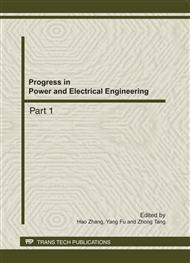[1]
X. Ma, C. Zhou and I.J. Kemp, "Automated Wavelet Selection and Thresholding for PD Detection", IEEE Electrical Insulation Magazine, Vol. 18, No. 2, pp.37-45, 2002.
DOI: 10.1109/57.995398
Google Scholar
[2]
X. Ma, C. Zhou and, I.J. Kemp, "Interpretation of Wavelet Analysis and Its Application in Partial Discharge Detection", IEEE Transactions on Dielectrics and Electrical Insulation, Vol. 9, No. 3, pp.446-457, 2002.
DOI: 10.1109/tdei.2002.1007709
Google Scholar
[3]
I. Shim, J.J. Soraghan and W.H. Siew, "Detection of PD Utilizing Digital Signal Processing Methods Part 3: Open-Loop Noise Reduction", IEEE Electrical Insulation Magazine, Vol. 17, No. 1, pp.6-13, 2001.
DOI: 10.1109/57.901611
Google Scholar
[4]
A. Cavallini, A. Contin, G.C. Montanari and F. Puletti, "Advanced PD Inference in On-Field Measurements. Part I: Noise Rejection", IEEE Transaction on Dielectrics and Electrical Insulation, Vol. 10, No. 2, pp.216-224, 2003.
DOI: 10.1109/tdei.2003.1194102
Google Scholar
[5]
A. Contin, A. Cavallini, G.C. Montanari, G. Pasini and F. Puletti, "Digital Detection and Fuzzy Classification of Partial Discharge Signals", IEEE Transactions on Dielechics and Electrical Insulation, Vol. 9, No. 3, pp.335-348, 2002.
DOI: 10.1109/tdei.2002.1007695
Google Scholar
[6]
N.C. Sahoo, M.M.A. Salama and R. Bartnikas, "Trends in Partial Discharge Pattern Classification: A Survey, " IEEE Transactions on Dielectrics and Electrical Insulation, Vol. 12, No. 2, pp.248-264, 2005.
DOI: 10.1109/tdei.2005.1430395
Google Scholar
[7]
G.C. Montanari, A. Cavallini and F. Puletti, "A New Approach to Partial Discharge Testing of HV Cable Systems", IEEE Electrical Insulation Magazine, Vol. 22, No. 1, pp.14-23, 2006.
DOI: 10.1109/mei.2006.1618967
Google Scholar
[8]
A. Cavallini, G.C. Montanari, A. Contin and F. Puletti, "A New Approach to the Diagnosis of Solid Insulation Systems Based on PD Signal Inference", IEEE Electrical Insulation Magazine, Vol. 19, No. 2, pp.23-30, 2003.
DOI: 10.1109/mei.2003.1192033
Google Scholar
[9]
R.M. Rao and A.S. Bopardikar, "Wavelet Transforms: Introduction to Theory and Applications," Addison Wesley, first printing, 1998.
Google Scholar
[10]
S. Boggs, "The Case for Frequency Domain PD Testing in the Context of Distribution Cable," IEEE Electrical Insulation Magazine, Vol. 19, No. 4, pp.13-19, 2003.
DOI: 10.1109/mei.2003.1226730
Google Scholar
[11]
K. Wu1, T. Ijichi, T. Kato, Y. Suzuoki, F. Komori and T. Okamoto, "Contribution of Surface Conductivity to the Current Forms of Partial Discharges in Voids," IEEE Transactions on Dielectrics and Electrical Insulation, Vol. 12, No. 6, p.pp.1116-1124, 2005.
DOI: 10.1109/tdei.2005.1561791
Google Scholar


